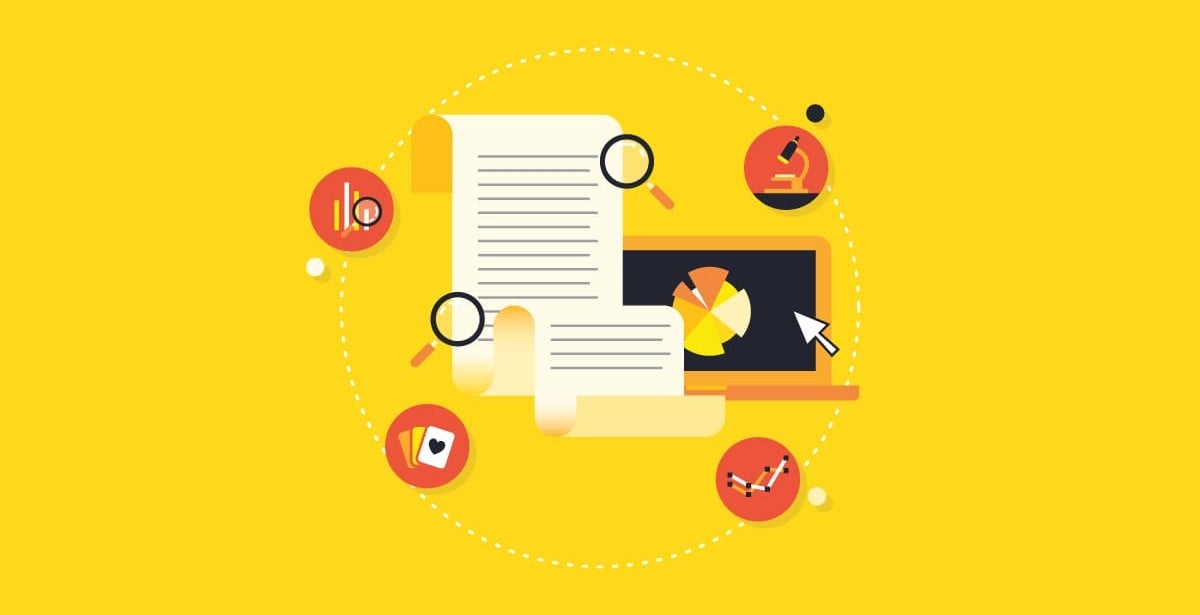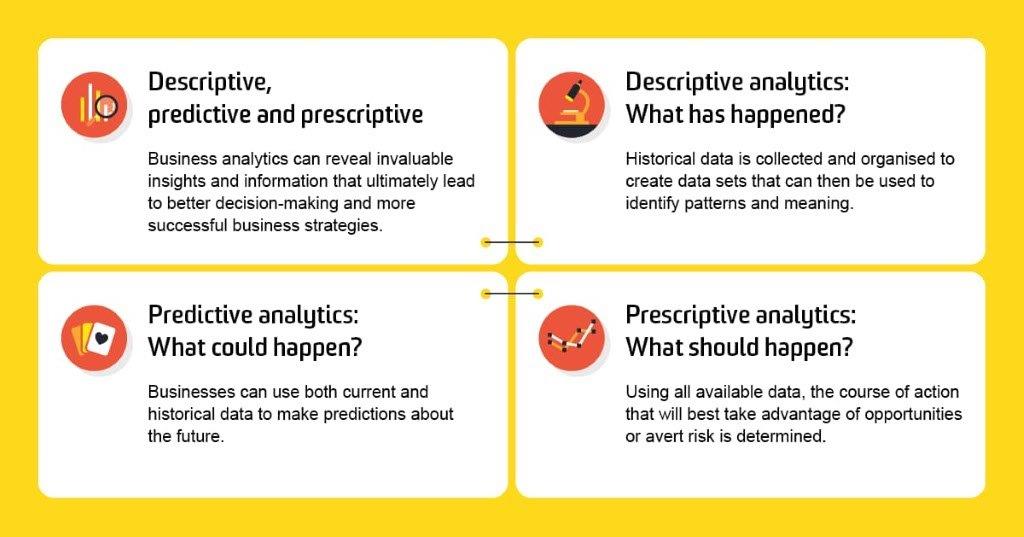Descriptive, predictive and prescriptive analytics: What are the differences?

Businesses use analytics to explore and examine their data and then transform their findings into insights that ultimately help executives, managers and operational employees make better, more informed business decisions. Three key types of analytics businesses use are descriptive analytics, what has happened in a business; predictive analytics, what could happen; and prescriptive analytics, what should happen. While each of these methodologies offers its own unique insights, advantages and disadvantages in their application, used in combination these analytics tools can be an especially powerful asset to a business.
When using data, it’s important to consider the Australian Government’s guide to data analytics and the Australian Privacy Principles. This guide outlines how individual privacy should be taken into account when data is used by government agencies and the private sector, as well as how the Australian Privacy Principles apply to data analytics. Guidelines such as these are increasingly necessary for regulation as more and more businesses look to big data (large, complex data sets) to increase revenue and improve business efficiency and effectiveness.
What is descriptive analytics?
Descriptive analytics is a commonly used form of data analysis whereby historical data is collected, organised and then presented in a way that is easily understood. Descriptive analytics is focused only on what has already happened in a business and, unlike other methods of analysis, it is not used to draw inferences or predictions from its findings. Descriptive analytics is, rather, a foundational starting point used to inform or prepare data for further analysis down the line.
Generally, the most simplistic form of data analytics, descriptive analytics uses simple maths and statistical tools, such as arithmetic, averages and per cent changes, rather than the complex calculations necessary for predictive and prescriptive analytics. Visual tools such as line graphs and pie and bar charts are used to present findings, meaning descriptive analytics can – and should – be easily understood by a wide business audience.
How does descriptive analytics work?
Descriptive analytics uses two key methods, data aggregation and data mining (also known as data discovery), to discover historical data. Data aggregation is the process of collecting and organising data to create manageable data sets. These data sets are then used in the data mining phase where patterns, trends and meaning are identified and then presented in an understandable way.
IBM Business Analytics Blog guest writer Dan Vesset breaks the descriptive analytics process into five broad steps:
- Business metrics are decided. First, metrics are created that will effectively evaluate performance against business goals, such as improving operational efficiency or increasing revenue. Vesset says the success of descriptive analytics heavily relies on KPI (key performance indicator) governance. ‘Without governance,’ he writes, ‘there may not be consensus regarding what the data means, thus guaranteeing analytics a marginal role in decision making.’
- The data required is identified. Data is sourced from repositories such as reports and databases. ‘To measure accurately against KPIs,’ Vesset says, ‘companies must catalogue and prepare the correct data sources to extract the needed data and calculate metrics based on the current state of the business.
- The data is collected and prepared. Data preparation – depublication, transformation and cleansing, for example – takes place before the analysis stage and is a critical step to ensure accuracy; it is also one of the most time-consuming steps for the analyst.
- The data is analysed. Summary statistics, clustering, pattern tracking and regression analysis are used to find patterns in the data and measure performance.
- The data is presented. Finally, charts and graphs are used to present findings in a way that non-analytics experts can understand.
What can descriptive analytics tell us?
Descriptive analytics is frequently used in the day-to-day operations of an organisation. Company reports – such as those on inventory, workflow, sales and revenue – are all examples of descriptive analytics that provide a historical review of an organisation’s operations. Data collected by these kinds of reports can be easily aggregated and used to create snapshots of an organisation’s operations.
According to online learning platform DeZyre, social analytics are almost always an example of descriptive analytics. The number of followers, likes and posts can be used to determine the average number of replies per post, the number of page views and the average response time, for example. The comments that people post on Facebook or Instagram are also examples of descriptive analytics and can be used to better understand user attitudes.
Descriptive analytics does not, however, attempt to go beyond the surface data and analysis; additional investigation falls outside the domain of descriptive analytics, and insights learned from descriptive analysis are not used for making inferences or predictions. What this methodology can reveal, though, are patterns and meaning through the comparison of historical data. An annual revenue report, for example, may appear to be financially reassuring in isolation until it is compared to the same reports from previous years, and together they reveal a downward trend.

The advantages and disadvantages of descriptive analytics
Since descriptive analytics relies only on historical data and simple calculations, this methodology can easily be applied in day-to-day operations, and its application doesn’t necessarily require an extensive knowledge of analytics. This means that businesses can relatively quickly and easily report on performance and gain insights that can be used to make improvements.
On the other hand, descriptive analytics has the obvious limitation that it doesn’t look beyond the surface of the data – this is where predictive and prescriptive analytics come into play.
Examples of descriptive analytics
Descriptive analytics helps organisations measure performance to ensure goals and targets are being met. And if they aren’t being met, descriptive analytics can identify areas that require improvement or change.
Some examples of how descriptive analytics can be used include the following:
- Summarising past events such as sales and operations data or marketing campaigns
- Social media usage and engagement data such as Instagram or Facebook likes
- Reporting general trends
- Collating survey results
What is predictive analytics?
While descriptive analytics focuses on historical data, predictive analytics, as its name implies, is focused on predicting and understanding what could happen in the future. Analysing past data patterns and trends by looking at historical data and customer insights can predict what might happen going forward and, in doing so, inform many aspects of a business, including setting realistic goals, effective planning, managing performance expectations and avoiding risks.
How does predictive analytics work?
Predictive analytics is based on probabilities. Using a variety of techniques – such as data mining, statistical modelling (mathematical relationships between variables to predict outcomes) and machine learning algorithms (classification, regression and clustering techniques) – predictive analytics attempts to forecast possible future outcomes and the likelihood of those events. To make predictions, machine learning algorithms, for example, take existing data and attempt to fill in the missing data with the best possible guesses.
A newer branch of machine learning is deep learning, which, according to Cornerstone Performance Management, mimics the construction of ‘human neural networks as layers of nodes that learn a specific process area but are networked together into an overall prediction.’ Deep learning examples include credit scoring using social and environmental analysis and sorting digital medical images such as X-rays to automate predictions for doctors to use when diagnosing patients.
What can predictive analytics tell us?
Since predictive analytics can tell a business what could happen in the future, this methodology empowers executives and managers to take a more proactive, data-driven approach to business strategy and decision making. Businesses can use predictive analytics for anything from forecasting customer behaviour and purchasing patterns to identifying sales trends. Predictions can also help forecast such things as supply chain, operations and inventory demands.
What are the advantages and disadvantages of predictive analysis?
Since predictive analysis is based on probabilities, it can never be completely accurate – but it can act as a vital tool to forecast possible future events and inform effective business strategy for the future. Predictive analytics can also improve many areas of a business, including:
- Efficiency, which could include inventory forecasting
- Customer service, which can help a company gain a better understanding of who their customers are and what they want in order to tailor recommendations
- Fraud detection and prevention, which can help companies identify patterns and changes
- Risk reduction, which, in the finance industry, might mean improved candidate screening
This method of analysis relies on the existence of historical data, usually large amounts of it.
Examples of predictive analysis
The ways predictive analytics can be utilised to forecast possible events and trends across industries and businesses is vast and varied. The healthcare industry, as an example, is a key beneficiary of predictive analytics. In 2019, RMIT University partnered with Digital Health Cooperative Research Centre to develop clinical decision support software for aged care that will reduce emergency hospitalisations and predict patient deterioration by interpreting historical data and developing new predictive analytics techniques. The goal is that predictive analytics will allow aged-care providers, residents and their families to better plan for the end of life.
Other examples of industries in which predictive analysis can be used, according to data analytics firm Sisense, include the following:
- E-commerce – predicting customer preferences and recommending products to customers based on past purchases and search history
- Sales – predicting the likelihood that customers will purchase another product or leave the store
- Human resources – detecting if employees are thinking of quitting and then persuading them to stay
- IT security – identifying possible security breaches that require further investigation
- Healthcare – predicting staff and resource needs

What is prescriptive analytics?
If descriptive analytics tells you what has happened and predictive analytics tells you what could happen, then prescriptive analytics tells you what should be done. This methodology is the third, final and most advanced stage in the business analysis process and the one that calls businesses to action, helping executives, managers and operational employees make the best possible decisions based on the data available to them.
How does prescriptive analytics work
Prescriptive analytics takes what has been learned through descriptive and predictive analysis and goes a step further by recommending the best possible courses of action for a business. This is the most complex stage of the business analytics process, requiring much more specialised analytics knowledge to perform, and for this reason it is rarely used in day-to-day business operations.
In order to make predictions and recommendations, Halo Business Intelligence notes that a number of techniques and tools – such as rules, statistics and machine learning algorithms – can be applied to available data, including both internal data (from within the business) and external data (such as data derived from social media). The capabilities of machine learning extend far beyond what a human can do when trying to achieve the same results.
A common misbelief is that predictive analytics and machine learning are the same thing. While predictive analytics looks at historical data using statistical techniques to make predictions about the future, machine learning, a subset of artificial intelligence, refers to the ability of a computer system to understand large – often huge – amounts of data, without explicit directions, and while doing so adapt and become increasingly smarter.
What can prescriptive analytics tell us?
Prescriptive analytics anticipates what, when and, importantly, why something might happen. After considering the possible implications of each decision option, recommendations can then be made in regard to which decisions will best take advantage of future opportunities or mitigate future risks. Essentially, Halo Business Intelligence says, prescriptive analytics predicts multiple futures and, in doing so, makes it possible to consider the possible outcomes for each before any decisions are made.
When prescriptive analytics is performed effectively, findings can have a real impact on business strategy and decision making to improve things such as production, customer experience and business growth.
What are the advantages and disadvantages of prescriptive analytics?
Prescriptive analytics, when used effectively, provides invaluable insights in order to make the best possible, data-based decisions to optimise business performance. However, as with predictive analytics, this methodology requires large amounts of data to produce useful results, which isn’t always available. Also, machine learning algorithms, on which this analysis often relies, cannot always account for all external variables. On the flip side, the use of machine learning dramatically reduces the possibility of human error.
Examples of prescriptive analytics
According to Inside Info, a commonly used prescriptive analytics tool is GPS technology, since it provides recommended routes to get the user to their desired destination based on such things as journey time and road closures. In this instance, prescriptive analysis ‘optimises an objective that measures the distances from your starting point to your destination and prescribes the optimal route that has the shortest distance.’
Other areas of prescriptive analysis application, according to data analytics firm Sisense, include the following:
- Oil and manufacturing – tracking fluctuating prices
- Manufacturing – improving equipment management, maintenance, price modelling, production and storage
- Healthcare – improving patient care and healthcare administration by evaluating things such as rates of readmission and the cost-effectiveness of procedures
- Insurance – assessing risk in regard to pricing and premium information for clients
- Pharmaceutical research – identifying the best testing and patient groups for clinical trials.

The future of analytics
Businesses are increasingly utilising data to discover insights that can aid them in creating business strategy, making decisions and delivering better products, services and personalised online experiences. While business analytics is a broad field, when looking at these three distinct methodologies – descriptive, predictive and prescriptive – their potential usefulness is clearly vast. When used in combination, these different methods of analysis are extremely complementary and valuable to business success and survival.
However, many Australian businesses have been slow to implement effective business analytics as part of their strategies and to take advantage of the data available. The Analytics Impact Index, a study of 400 high-revenue-earning international businesses, showed that Australian businesses are falling short when compared to other international businesses. In terms of ‘analytics maturity and excellence’, the study showed that the majority of Australian companies fell into the ‘laggard’ category, which describes companies that only use limited descriptive analysis of data, don’t have a clearly defined analytics strategy and also lack the structures and cultures required to form one. The study cited a lack of sufficiently trained in-house analytics staff, risk-averse cultures, a reluctance to experiment, as well as a lack of leadership and strategy for the shortcoming.
But this seems to be changing in the near future. Deloitte’s Global Perspectives for Private Companies Report shows that business intelligence and data analytics are areas in which many Australian private companies plan to invest in the future. Creating an in-house staff of analytics specialists can be costly, however, especially when implementing more advanced analytics, and for some businesses bringing analytics into their business strategy may require outsourcing the work to an analytics team. Either way, the investment is worthwhile – the Analytics Impact Index showed that business leaders in analytics see 60 per cent more profits than those described as laggards – and for this reason the adoption of business analytics will undoubtedly increase markedly in coming years.
Learn more about analytics
As more and more Australian companies begin to invest in analytics, professionals can meet the demand by earning a degree that fast-tracks their path to a rewarding and dynamic analytics career. UNSW Sydney Online’s Master of Analytics program enables busy professionals to earn a comprehensive advanced degree in as little as 2 years without compromising their career. Completion time dependent on individual study path, RPL, leave and course availability. Please speak to a Student Advisor for more information. Learn more about the program today and take the next step towards a rewarding career.









